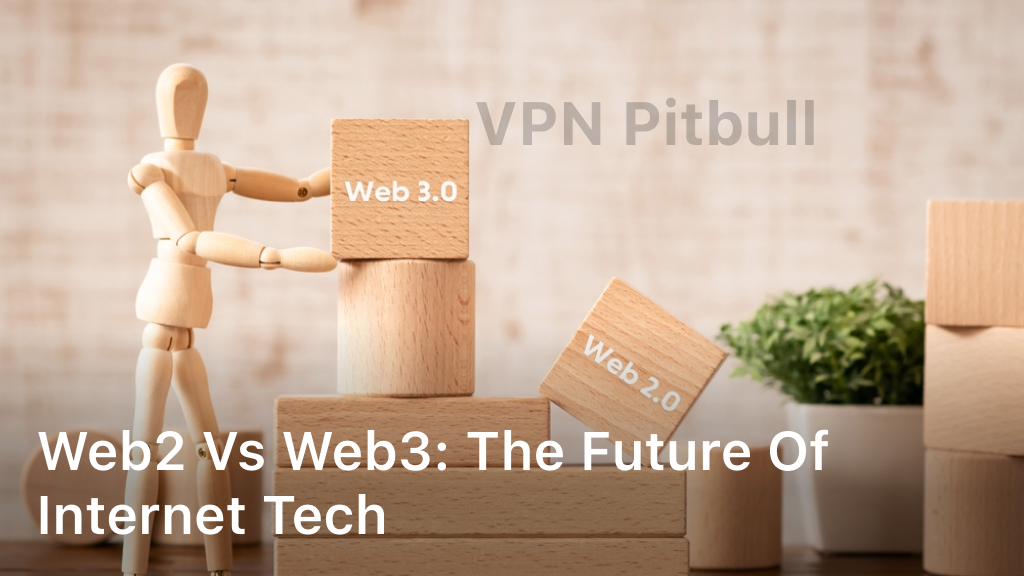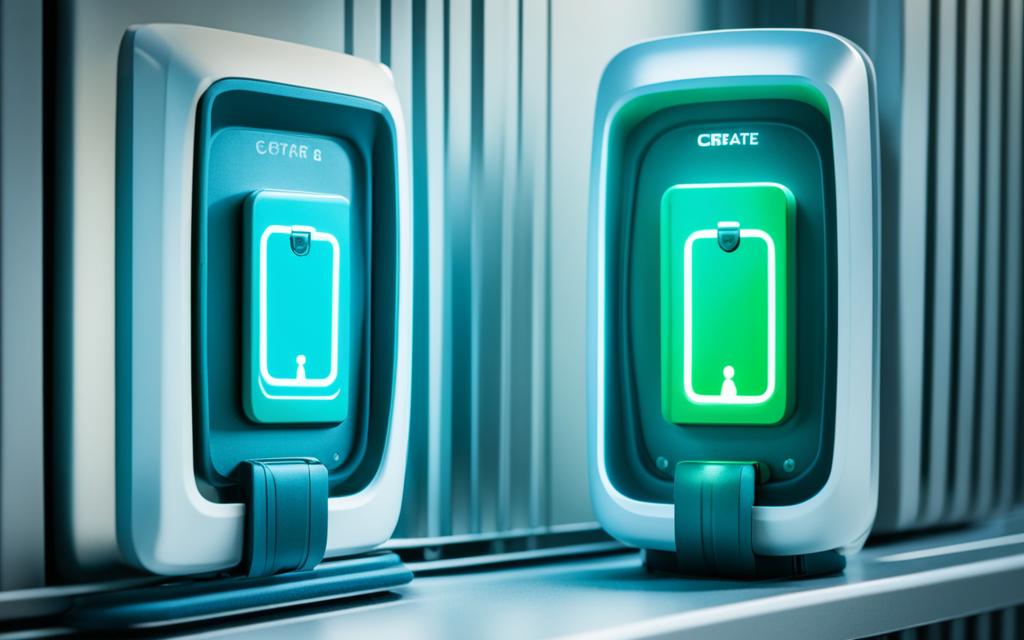Web2 vs Web3: The Future of Internet Tech
Welcome to the dynamic world of Web2 vs Web3 technology! As we navigate the ever-evolving landscape of the internet, it is crucial to understand the key differences between Web2 and Web3 and their impact on the future of online interaction.
Web2, the current state of the internet, has revolutionized the way we connect and engage with digital content. It empowers users to create, share, and consume information easily. However, as technology advances, a new era is emerging – Web3.
Web3 introduces a decentralized model, shifting the power from centralized authorities to individuals. This paradigm shift brings forth numerous advantages, including enhanced privacy, improved security, and ownership of data. Web3’s potential to reshape industries and revolutionize the way we interact with technology cannot be underestimated.
So, what are the key differences between Web2 and Web3? How do their features and advantages diverge? In this article, we will explore the fundamental contrasts between these two technologies, shedding light on their distinctive characteristics and transformational potentials.
Join us on this enlightening journey as we delve into the world of Web2 vs Web3, uncovering the nuances that will shape the future of internet technology.

Understanding Web2 Technology
Web2 technology refers to the second generation of internet technologies that transformed the way we interact with the web. Unlike its predecessor, Web1, Web2 is characterized by dynamic and interactive features that enable user-generated content and collaboration. This shift from static, one-way information dissemination to a more participatory and social web has revolutionized the online experience.
Features of Web2 Technology
Web2 technology incorporates various features that enhance user engagement and interactivity. Some key features include:
- User-generated content: Web2 platforms allow users to create, share, and publish their own content, fostering a sense of online community and empowering individuals to contribute to the web ecosystem.
- Social networking: Web2 introduced social networking platforms that connect people worldwide, enabling them to share updates, photos, and connect with friends and family.
- Rich media: Web2 enables the incorporation of multimedia elements such as images, audio, and video, enhancing the visual and auditory experience for users.
- Interactivity: Web2 facilitates two-way communication between users and websites, allowing for real-time interactions, feedback, and customization.
Advantages of Web2 Technology
Web2 technology has brought numerous benefits to users and businesses alike. Some advantages include:
- Enhanced user experience: The interactive nature of Web2 platforms provides a rich and personalized user experience, allowing individuals to explore, engage, and find relevant content.
- Collaboration and knowledge sharing: Web2 technology has fostered a collaborative environment, enabling users to share knowledge, expertise, and insights with a global audience.
- Business opportunities: Web2 platforms have opened up new avenues for businesses to market their products and services, connect with customers, and gather valuable user data for targeted marketing campaigns.
- Increased accessibility: Web2 has made the internet more accessible to a wider audience, breaking down geographical barriers and providing equal opportunities for individuals to participate and contribute.
In conclusion, Web2 technology has revolutionized the internet by introducing dynamic and interactive features that empower users, foster collaboration, and enhance the overall online experience. Understanding the features and advantages of Web2 is crucial in appreciating the subsequent advancements in Web3 technology, as discussed in the following section.
Exploring the Potential of Web3 Technology
In this section, we will dive into the exciting emergence of Web3 technology and explore its unique features. Web3 represents a paradigm shift from the traditional Web2 approach, offering a decentralized and user-centric internet experience.
One of the key advantages of Web3 technology is its decentralized nature. Unlike Web2, where data is stored and controlled by centralized entities, Web3 operates on decentralized networks powered by blockchain technology. This decentralization brings enhanced privacy and security, as user data is spread across multiple nodes, reducing the risk of unauthorized access or data breaches.
Moreover, Web3 puts control back into the hands of individuals. With Web2, users often surrender ownership and control of their data to centralized platforms. Web3 empowers users by enabling them to own and control their data. This ensures that individuals have full authority over who can access their information and how it is used.
Web3 technology also holds immense potential for transforming various industries. Its decentralized nature and user-centric approach pave the way for innovative business models and new economic systems. Web3 allows for the development of decentralized applications (dApps) that operate without the need for intermediaries, enabling peer-to-peer interactions and fostering trustless systems.
Web3 Features:
- Decentralization
- User-owned data
- Enhanced privacy and security
- Development of innovative business models
- Creation of trustless systems
The transition to Web3 technology brings a new era of possibilities, where individuals have greater control over their online experiences and the potential for disruptive innovation is boundless. As we delve deeper into the comparison between Web2 and Web3 in the next section, we will gain a comprehensive understanding of the key differences and implications of these two technologies.
Key Differences between Web2 and Web3
In order to understand the future of internet technology, it is essential to examine the key differences between Web2 and Web3. While both terms refer to different generations of internet technology, they have distinct characteristics and implications for users and businesses. This section will delve into several aspects that set Web2 and Web3 apart, including data control, user privacy, innovation, governance, and economic models.
Data Control
One of the fundamental differences between Web2 and Web3 lies in the control of data. In the Web2 model, data is primarily stored and controlled by centralized entities such as tech giants and social media platforms. This centralized control raises concerns about data privacy and security, as user data can be accessed and exploited without consent. On the other hand, Web3 embraces decentralization, allowing users to have greater control over their own data. Blockchain and distributed ledger technologies enable users to store their data securely and grant or revoke access as they see fit.
User Privacy
Web2 has been criticized for its lack of user privacy. With centralized platforms, users often surrender personal information and preferences in exchange for services. This data is then used for targeted advertising and other purposes, compromising user privacy. In contrast, Web3 prioritizes privacy by design. Through encrypted protocols and decentralized systems, Web3 ensures that user information remains confidential and only accessible to authorized individuals.
Innovation
Web2 has been a catalyst for innovation, enabling the development of numerous applications and services that have transformed various industries. However, innovation within Web2 is largely controlled by centralized entities, limiting the degree of creativity and openness. Web3, on the other hand, fosters innovation through decentralized networks and open-source development. This allows for greater collaboration and experimentation, leading to the creation of novel and disruptive solutions.
Governance
When it comes to governance, Web2 and Web3 follow different models. In the Web2 landscape, decision-making and governance are primarily controlled by centralized authorities or organizations. This can result in a lack of transparency and limited user participation in important decisions. In contrast, Web3 embraces decentralized governance, giving users a voice in the decision-making process through consensus mechanisms and decentralized autonomous organizations (DAOs).
Economic Models
The economic models of Web2 and Web3 also diverge significantly. In Web2, revenue generation mainly relies on traditional advertising models, with centralized platforms serving as intermediaries between advertisers and users. On the other hand, Web3 introduces new economic models, such as tokenization and decentralized finance (DeFi). These models enable users to directly monetize their digital assets and participate in decentralized ecosystems, leading to a more equitable and inclusive economy.
| Aspect | Web2 | Web3 |
|---|---|---|
| Data Control | Centralized control by tech giants | Decentralized control by users through blockchain |
| User Privacy | Limited privacy, data exploitation | Enhanced privacy, confidentiality |
| Innovation | Controlled by centralized entities | Open collaboration and experimentation |
| Governance | Centralized decision-making | Decentralized governance through DAOs |
| Economic Models | Traditional advertising models | Tokenization and DeFi |
Conclusion
In conclusion, the rise of Web3 technology marks a significant shift in the landscape of the internet. Web2 and Web3 represent two distinct approaches to how we interact with and utilize online platforms.
Web2 technology, characterized by centralized control and user-generated content, has revolutionized the way we connect, share, and collaborate online. Its features such as social networking, collaborative tools, and cloud computing have empowered users and businesses alike, offering convenience and accessibility.
On the other hand, Web3 technology introduces a decentralized paradigm, promoting privacy, security, and ownership of data. Through blockchain technology and decentralized applications, Web3 strives to create a truly user-centric internet, where individuals have control over their own information and can participate in decentralized ecosystems.
Understanding the differences between Web2 and Web3 is crucial as we navigate the future of the internet. While Web2 brings convenience and interactivity, Web3 holds the promise of a more secure and transparent online experience. By embracing Web3, we can unlock the full potential of decentralized technologies, leading to innovative solutions and a more inclusive digital world.
FAQ
What is the difference between Web2 and Web3?
Web2 refers to the current state of the internet, characterized by centralized platforms and services. Web3, on the other hand, represents the future of the internet, built on decentralized technologies like blockchain.
What are the features of Web2 technology?
Web2 technology enables user-generated content, interactivity, and social networking. It allows users to consume and contribute to online platforms, fostering collaboration and communication.
What advantages does Web2 offer?
Web2 provides convenience, ease of use, and access to a wide range of services. It also enables businesses to connect with their target audience, build online communities, and monetize their platforms.
What is Web3 technology?
Web3 technology refers to the next generation of the internet, which is decentralized and built on blockchain and other peer-to-peer technologies. It aims to give users greater control over their data, privacy, and digital assets.
What are the features of Web3 technology?
Web3 technology features decentralized protocols, smart contracts, and digital currencies. It prioritizes privacy, security, and user ownership, allowing individuals to have full control over their online activities.
What advantages does Web3 offer?
Web3 offers enhanced user privacy, protection against data breaches, and the ability to directly engage in peer-to-peer transactions without intermediaries. It also encourages collaboration, trust, and innovation in various industries.
How does Web2 differ from Web3?
Web2 is centralized, controlled by a few entities, and relies on user trust in third parties. Web3, however, is decentralized, user-centric, and operates on trustless mechanisms, where users have greater control over their data and digital assets.
How does Web3 promote innovation compared to Web2?
Web3 promotes innovation through open-source protocols, smart contracts, and decentralized applications (DApps). It allows developers to build new services and platforms without relying on a centralized authority, fostering creativity and competition.
What role does governance play in Web2 and Web3?
In Web2, governance is often controlled by centralized entities. In contrast, Web3 adopts decentralized governance models through consensus mechanisms, allowing users to participate in decision-making processes and maintain network integrity.
How do the economic models of Web2 and Web3 differ?
Web2 generates revenue through advertisements, subscriptions, and data monetization. Web3, on the other hand, introduces token economics, where users are incentivized by tokens and can directly benefit from their contributions to the network.




